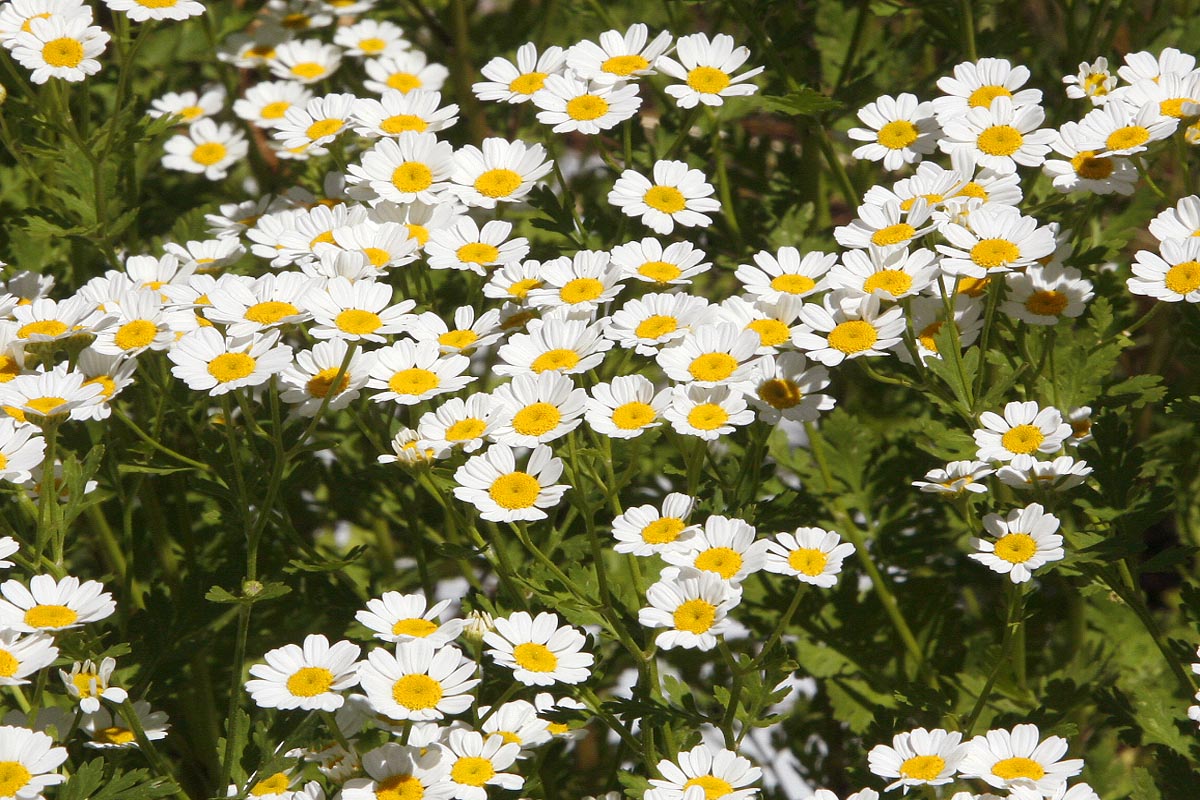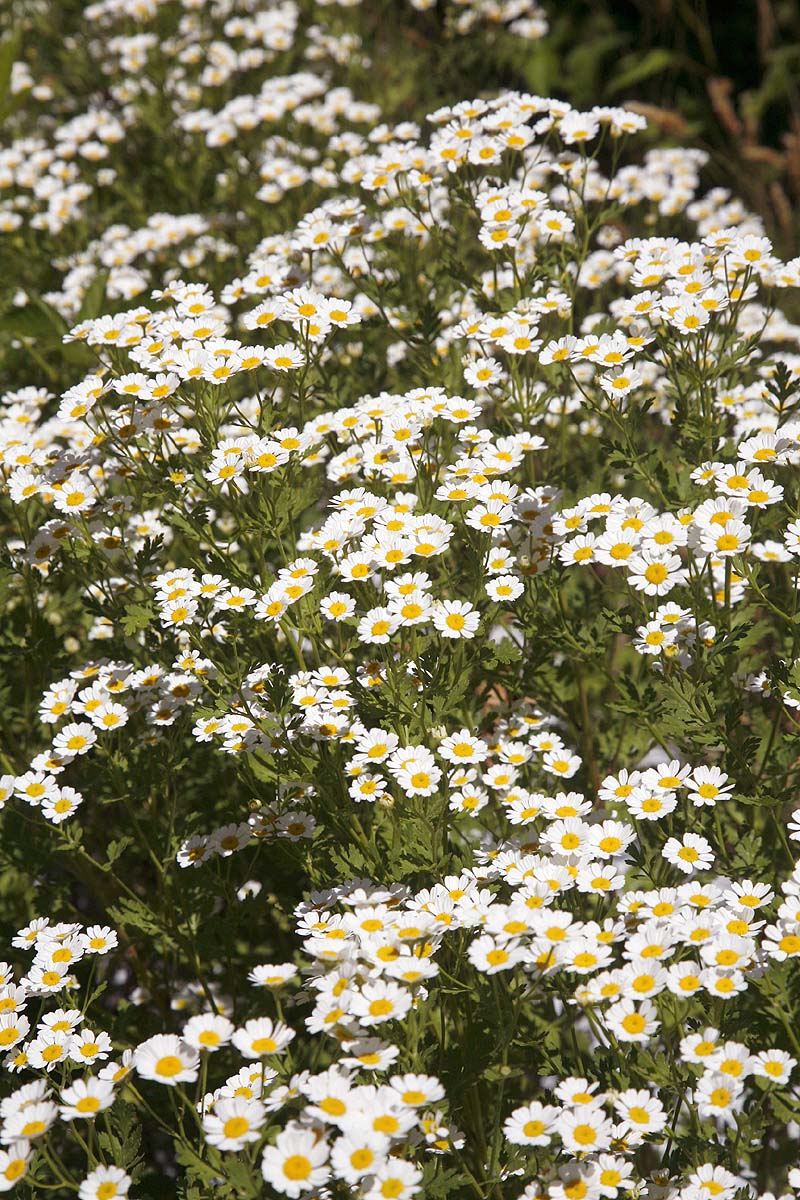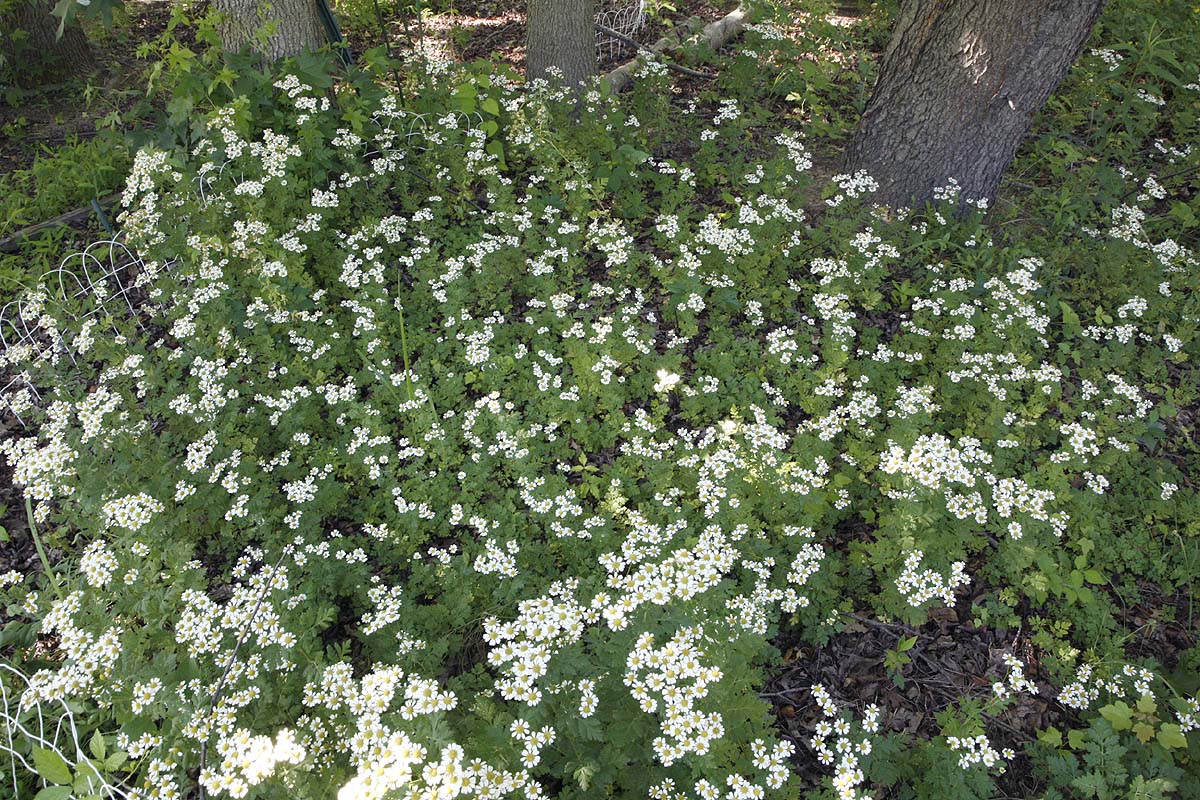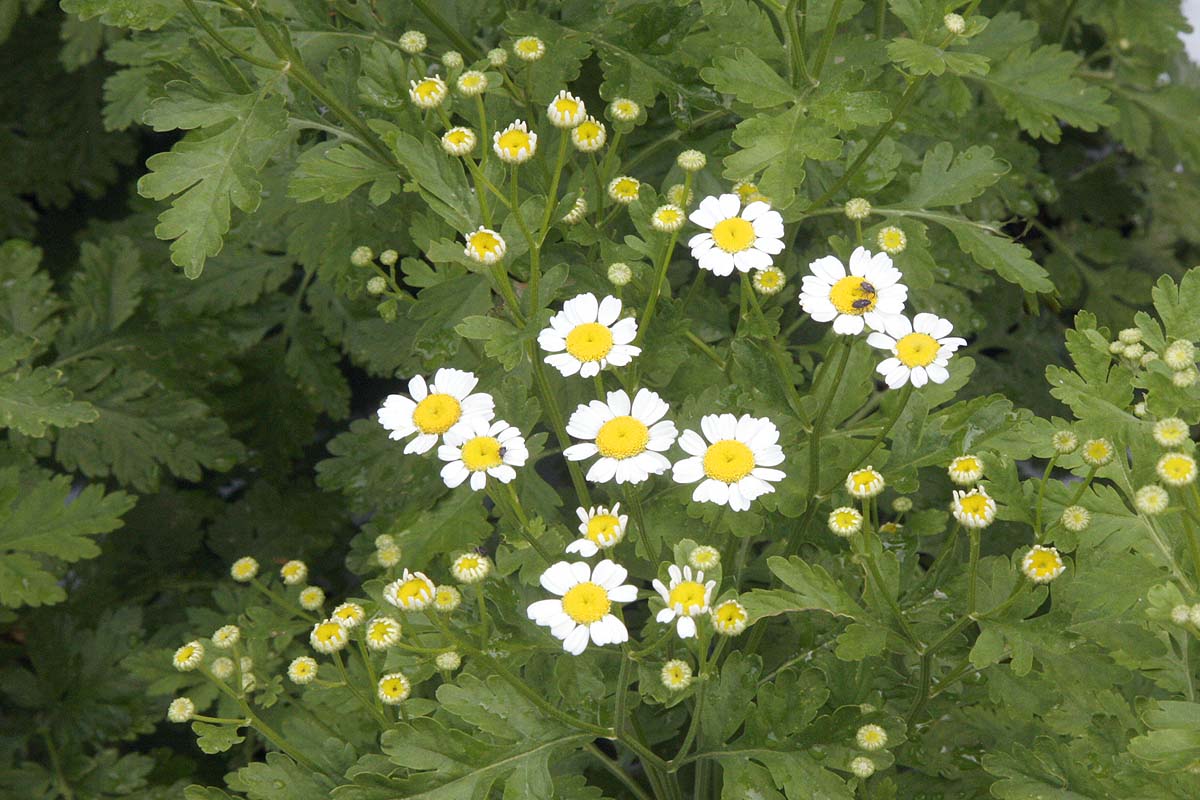A short lived perennial that often acts like an annual. In many cases it will produce a rosette of deep green leaves during the late summer or fall/autumn then grow rapidly in the spring into a large bushy plant with multitudes of lovely white daisy flowers with bright yellow centers. Hardy to zone 4 it prefers colder climates rather than hot ones. Very tough and will grow on very poor soil with little water, will even grow on almost pure gravel. Super easy to grow from seed, flowers in the first year. Will last for several years in areas that provides good habitat but may behave more like an annual in locations where its not so happy. Needs no maintenace although cutting down stalks in fall will help it overwinter better. Deer and rabbit proof.
Description of Feverfew (Tanacetum parthenium).
Produces a small clump of long stems anywhere from 4- 14 inches (10-36cm) long that are much branched providing a very bushy appearance. Leaves are mid to dark green in color and mostly compound in structure, meaning they are either deeply lobed or lobes are totally segmented and cut right to the central stem. Although wider they often resemble fern struture and each leaf can be up to 4 inches (8cm) long. Each stem in much branched and the top of each branch produces a single flower. Flowers are up to i inch (2cm) across with a ring of white petals that are either ovate or Truncate (oval with a blunt top) in shape around a large yellow center. Flowers begin in mid to late spring and can continue sporadically until early fall/autumn. Flowers are followed by rounded brown seed heads that hold many seeds.
Growing Feverfew (Tanacetum parthenium) from Seed.
Very easy to grow. Seeds require light to germinate so do not cover. Surface sow in place or start in late winter on sterile seeding mix. Keep moist but not wet at all times. For more information on starting seeds see our
General Growing Instructions.
Once seedlings reach a inch (2.5cm) in height they can be transplanted into individual pots and grown on to about 6 inches (15.2cm) before planting out. will usually flower the first year from seed.
Starting outdoors.
Seeds can be scattered on prepared soil either in early fall/autumn or very early spring when all the killing frosts have past. Mild frost will not inhibit germination or growth. Fall is a good time to begin as there are less weed seeds to contend with, however if seeds to not germinate quickly they may be prone to animal or bird predation.
Location and Care of Feverfew (Tanacetum parthenium).
Feverfew is a cool weather plant. While it is hardy from zones 4-9 it thrives better in cooler climates and can survive winter temperatures down to about -22°F (-30°C) when established. In zones above this it can be grown as a annual. It prefers climates with a cool period during the winter time where it can go semi dormant. It does not do well in more tropical settings where temperatures a high and even less where it is very humid so not a plant for the American south east.
Feverfew is a short lived perennial expect it to last 2-4 years depending on the location. If its happy where it is then it will stay, if its not it may behave like an annual. This can be within the same garden so check the locations it likes best and plant it there. Will self seed in areas where its happy.
Light. This is going to depend on your zone. In zones 4-5b full sun is ideal. In zones 6b-7b shade is required. It can tolerate some sunshine for a portion of the day but not full sun. If it self seeds it will be found in semi shaded areas, under trees and north sides of buildings. It makes an excellent plant for semi shaded areas where it can brighten the area with its white flowers. Shade from noon day sun if possible offering only early and late full sun.
In areas below 7b full shade will be required. Not heavy deep shade but under trees at the edges of woodland areas, north sides of structure or any other shade.
Soil. Must be well drained. Does not do well on heavy soils like clay that hold water. This plant will grow on sand or gravel with just a small amount of organic material (like rotted leaves) in it. Sandy loam soil is ideal. Does not need feeding and does well on poor soils but must be very well draining.
Water. Very little, provided there is regular rainfall. It is fairly drought tolerant once established but will wilt if drought is prolonged and will need help. Do not overwater as this will cause it to rot. Ideal for dry semi shaded areas, rocks around trees, rockeries and such areas.
Spacing. about 15 inches (45cm) apart is ideal the bushy growth habit will fill in the gaps providing a continuous mass of blooms. In areas where there is higher humidty wider spacing may be needed to help increase airflow through the bushy leaves and reduce mildew and fungal diseases.
Maintenance.
If flowers are cut off either when in bloom (for harvesting) or just after, about half way down the stem this can often promote a second blooming later in the summer to early fall/autumn. Cutting tall stems down to the base rosette before winter arrives can help plants overwinter better and come back stronger in the springtime when stalks would need to be removed anyway to produce tidy plants, as it will bloom from new stalks not old ones.
Pollinator and Wildlife with Feverfew (Tanacetum parthenium).
For the most part larger wildlife avoid feverfew due to its aromatic nature. Its very deer and rabbit resistant, occasionally a groundhog will take just one bite. Pollinators love the flowers mostly small native bees rather than honey bees and a variety of other pollinators and butterflies.
Rarely has any insect attacks except occaional leaf miners.
Harvesting Feverfew (Tanacetum parthenium).
Harvest flowers when plant is in full bloom. Some just harvest the blooms alone while others cut blooms are top leaves together. Dry blooms in warm, not hot air in dark to prevent blanching.
Culinary Uses of Feverfew (Tanacetum parthenium).
Not used, its bitter taste and possible mouth sores in some people do not make it popular.
Medical uses of Feverfew (Tanacetum parthenium).
Feverfew has been used for centuries and recent research has substanciated the original use as a great benefit in treating certain kinds of migrane headaches as well as rheumatisum and arthritis. A tea made from the leaves and flowers is also used to treat colds and fever as well as arthritis, care should be taken as there are reports that this can have mild sedative properties. It is important not to use fresh herb either flower or leaf directly as in some people it can cause unpleasent mouth sores. This is not occur if the herb is boiled first, as in a tea, or the herb is dried before use. Dried herb is often chewed to help with headaches are absorbtion through the mouth provides faster delivery of the herb. Fresh herb can be used this way but it is important to test first with a very small amount to ensure the person is no subject to mouth sores. Four leaves appear to be an effective dosage for migranes so do not over use.
If used on a continous basis Discontinuation may lead to rebound headaches, anxiety and insomnia
Other uses of Feverfew (Tanacetum parthenium).
Feverfew contains compounds that insects really dont like so it can be used as an effective insectacide. Soaking dried herb in hot soapy water than allowing to cool before using as a spray is reported to be very effective against a large number of insect species.
It can also be planted near or intermixed with vegetable crops to help repell insects naturally.
The dried flowers are also used in portpourri and wreaths both because of their attractive white flowers and also helps prevent insect attacks on other dried plants and around the home.
A yellow green dye can be extracted from the flowers for use in fabrics.
Other names
featherfew, featherfoil, febrifuge plant, bachelor's buttons, mid-summer daisy, nosebleed. wild chamomile, Flirtwort, Flirtroot,
Botanical Synonyms
Chrysanthemum parthenium, Leucanthemum parthenium, Pyrethrum parthenium, Matricaria parthenium










